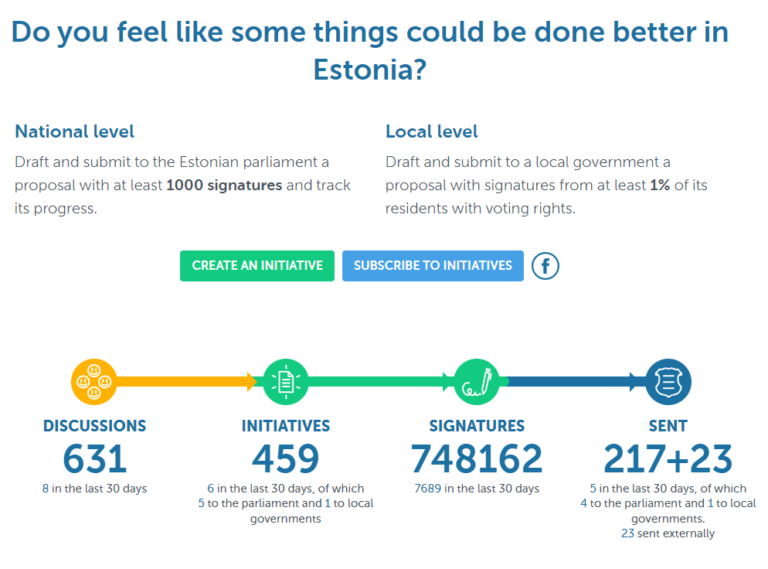January 24, 2024
by Carmen Raal

Article content
Trust in the state and democracy is in decline worldwide. Nobel Peace Prize winner Maria Ressa has warned that online misinformation significantly threatens democracy. In the face of a constantly evolving world and the rapid spread of misinformation online, it is crucial to confront modern challenges with modern solutions. I recently moderated a panel discussion in Estonian focusing on digital democracy, particularly highlighting Estonia’s unique Citizen Initiative portal, Rahvaalgatus.
I delved into the pivotal topic of participatory democracy with two experts – Maarja-Leena Saar, an expert from The Estonian Cooperation Assembly who also manages the Citizen Initiative portal, and Kristina Mänd, a senior expert on e-democracy from e-Governance Academy. Here are the highlights from our conversation with Maarja-Leena and Kristina.
A record-breaking unique platform
Established in 2016, Rahvaalgatus has demonstrated the remarkable engagement of Estonians in actively voicing their opinions alongside decision-makers. Rahvaalgatus allows us to make initiatives both on a national and local level. A proposal to the Parliament has to gather at least 1000 signatures, and for local government, a proposal has to gather signatures from at least 1% of its residents with voting rights.
"If the citizens have a user-friendly and convinient way to have a say in lawmaking, they will. The myth that Estonians do not like to have a say in
law-making has been completely shattered with Rahvaalgatus," said Maarja-Leena during the panel.

Rahvaalgatus serves as a potent weapon against the onslaught of populism. Social media tends to amplify extreme posts to garner more attention, often exacerbated by fake accounts. Thanks to Estonia’s secure eID system, Rahvaalgatus ensures a distortion-free representation of public views. This system effectively counters situations where a single individual could artificially inflate petition signatures, maintaining transparency. Notably, signatures are deleted once the petition completes its journey through all stages.
Moreover, Rahvaalgatus provides a comprehensive overview of issues concerning the Estonian public, distinguishing itself from social media algorithms that limit exposure to a fraction of conversations and opinions. This distinction allows for a more accurate reflection of true realities.
Last year Rahvaalgatus broke the record for e-elections in the Estonian Parliament with 313,868 digital signatures. On the platform, various collective appeals have already received more e-votes (313,868 as of December 2023) than the parliamentary elections (312,182) in 2023.
Initiatives undergo several phases after it has been published:
- Co-Creation Period:
The initiation phase involves a minimum three-day co-creation period. During this time, anyone interested in the initiative can suggest ideas for its improvement, with the author having the discretion to incorporate or disregard these suggestions.
2. Signature collection:
The next phase focuses on collecting signatures, with a maximum duration of 18 months.
3. Submission to local government or Parliament:
Upon surpassing the required signature threshold, a simple click forwards the initiative to the local government or parliament.
4. Review:
Upon reaching decision-makers, the initiative is assigned to a relevant commission mandated to discuss it within three months. During this period, the initiator is invited to participate.
5. Decision declaration:
Within six months, a position on the initiative must be declared. Any decisions made are promptly published online as open-sourced data. Subscribers to the initiative receive immediate notifications of these developments.

After the time-consuming process is over, all the signatures get deleted.
Surprisingly, no initiative has necessitated removal due to hate speech. While some initiatives have teetered on the edge, their lack of widespread support led to the decision not to intervene at any stage of their progression.
Fostering a digital society with a pivotal role in participatory democracy necessitates a leadership attuned to the digital landscape. This involves public sector employees and politicians being well-versed in the platforms where discussions unfold. It’s crucial to note that speedy decision-making doesn’t inherently equate to a well-informed decision. Furthermore, the repercussions of hastily made decisions within a limited circle may take longer to resolve than if a broader discussion had occurred.
Inclusion is not a one-time act but rather a systemic approach, emphasizing the importance of adhering to established processes. This involves ensuring transparency and uniform rules applicable to everyone, irrespective of their political views.
Various initiative types include:
- Demonstrations:
Primarily, it is a responsive action expressing dissatisfaction with a decision.
- Reaction to legislative decisions:
A reactive approach towards hastily made legislation that lacks the involvement of essential stakeholders.
- Long-term advocacy work:
Primarily focused on human rights and environmental issues, often led by organizations.
- Grassroots initiatives:
It utilises less formal language than the former category but remains significant, involving individuals who may not frequently engage in participatory democracy.
In conclusion, Rahvaalgatus, has emerged as a powerful instrument, showcasing the active engagement of Estonians in shaping their nation’s discourse. In the face of rising populism and the distortions exacerbated by social media, Rahvaalgatus stands out as a countermeasure. Rahvaalgatus distinguishes itself by offering a comprehensive overview of issues, overcoming the limitations imposed by social media algorithms. This distinction results in a more accurate reflection of the diverse realities shaping Estonian public opinion. Rahvaalgatus continues to empower Estonians to actively participate in the democratic processes that shape their nation’s future.
Resouce: e-estonia
